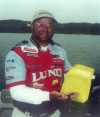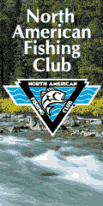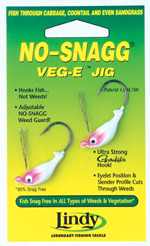 |
|

Click here to Check out the New Leech Tamer and order online Promotional Team Favorites Lodging food and more 
|
By Ted Takasaki and Scott Richardson Want to have some fun? Try targeting big walleyes in shallow water.
Anglers who claim walleyes don't fight as hard as other species have probably
never hooked a 4 or 5-pound walleye in 3-feet of water.
Focus on the points and turns on the deep side first. Stay back from the edge and make short flips to the targets. Most casts should be under 15 feet. Twenty feet is a long one. The Veg-E-Jig's wire hook guard will keep it from hanging up. But, if you should tangle, simply pull it free. Hits often come as the bait pops loose. Bring the jig back with a fast lift, reel, lift, reel motion. Shallow fish are not bashful. Try moving closer to pitch into the pockets of the green stuff. Weeds are best on calm days. But, a second shallow pattern relies on the wind. Sustained, strong breezes will blow plankton to the windy side of a lake. That rings the dinner bell for minnows that attracts walleyes into shallow water. Wind also stirs the bottom so walleyes can use their sight to good advantage. At this time, target windy points and the windy side of islands. Try Timb'r Rock Jigs tipped with a minnow, leech or a piece of nightcrawler. Or, choose a shallow-running crankbait that will dive deep enough to tick across the rocks as you retrieve. Use your trolling motor to move along the structure. Anchor and cast if the wind blows too hard to control your boat. Retie often to avoid a nick to the line that could cost you a trophy fish. You're not limited to casting lures or jigs in shallow water. In fact, there are some lakes where trolling is the best way to locate shallow fish fast. Trolling with the gasoline-powered kicker can also give you boat control you may lack in the wind fishing other ways. Use 12-pound Stren MagnaThin on 8-foot St. Croix Pro-Glass GT80M rods. Use line-counter reels to precisely control the depth of lures. The more line out, the deeper they go until they reach the maximum depth of their diving range. Get out the lake map and identify stretches of shoreline or islands on the windy side of the lake with as many different features as possible, like points and turns. Areas with slow sloping shoreline and subtle changes in bottom composition are best. Depending on state law, mount as many rods as you are allowed on the shallow side of the boat. Use good rod holders, like Tempress’ Fish On’s, and planer boards to get your lures as close as possible to the shoreline. Use at least one line to target the "mud line" where water clarity changes from murky to clear. Follow the contour of the shoreline watching your depth finder to stay a safe distance from the rocks. Don't stay in deep water all the time. Shallow water rocks!
Fish Clix Banner Exchange Please visit these site sponsors |
|---|---|
